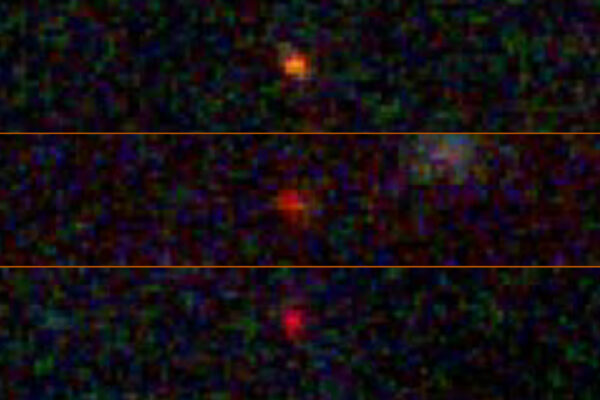AUSTIN, Texas — Stars beam brightly out of the darkness of space thanks to fusion, atoms melding together and releasing energy. But what if there’s another way to power a star?
A team of astrophysicists including Katherine Freese at The University of Texas at Austin analyzed images from the James Webb Space Telescope (JWST) and found three bright objects that might be “dark stars,” theoretical objects much bigger and brighter than our sun, powered by particles of dark matter annihilating. If confirmed, dark stars could reveal the nature of dark matter, one of the deepest unsolved problems in all of physics.
“Discovering a new type of star is pretty interesting all by itself, but discovering it’s dark matter that’s powering this—that would be huge,” said Freese, director of the Weinberg Institute for Theoretical Physics and the Jeff and Gail Kodosky Endowed Chair in Physics at UT Austin.
Although dark matter makes up about 25% of the universe, its nature has eluded scientists. Scientists believe it consists of a new type of elementary particle, and the hunt to detect such particles is on. Among the leading candidates are Weakly Interacting Massive Particles. When they collide, these particles annihilate themselves, depositing heat into collapsing clouds of hydrogen and converting them into brightly shining dark stars. The identification of supermassive dark stars would open up the possibility of learning about the dark matter based on their observed properties.
The research is published in the Proceedings of the National Academy of Sciences. Along with Freese, the co-authors are Cosmin Ilie and Jillian Paulin at Colgate University.
Follow-up observations from JWST of the objects’ spectroscopic properties — including dips or excess of light intensity in certain frequency bands — could help confirm whether these candidate objects are indeed dark stars.
Confirming the existence of dark stars might also help solve a problem created by JWST: There seem to be too many large galaxies too early in the universe to fit the predictions of the standard model of cosmology.
“It’s more likely that something within the standard model needs tuning, because proposing something entirely new, as we did, is always less probable,” Freese said. “But if some of these objects that look like early galaxies are actually dark stars, the simulations of galaxy formation agree better with observations.”
The three candidate dark stars (JADES-GS-z13-0, JADES-GS-z12-0, and JADES-GS-z11-0) were originally identified as galaxies in December 2022 by the JWST Advanced Deep Extragalactic Survey (JADES). Using spectroscopic analysis, the JADES team confirmed the objects were observed at times ranging from about 320 million to 400 million years after the Big Bang, making them some of the earliest objects ever seen.
“When we look at the James Webb data, there are two competing possibilities for these objects,” Freese said. “One is that they are galaxies containing millions of ordinary, population-III stars. The other is that they are dark stars. And believe it or not, one dark star has enough light to compete with an entire galaxy of stars.”
Dark stars could theoretically grow to be several million times the mass of our sun and up to 10 billion times as bright as the sun.
The idea for dark stars originated in a series of conversations between Freese and Doug Spolyar, at the time a graduate student at the University of California, Santa Cruz. They wondered: What does dark matter do to the first stars to form in the universe? Then they reached out to Paolo Gondolo, an astrophysicist at the University of Utah, who joined the team. After several years of development, they published their first paper on this theory in the journal Physical Review Letters in 2008.
Funding for this research was provided by the U.S. Department of Energy’s Office of High Energy Physics program and the Vetenskapsradet (Swedish Research Council) at the Oskar Klein Centre for Cosmoparticle Physics at Stockholm University.




